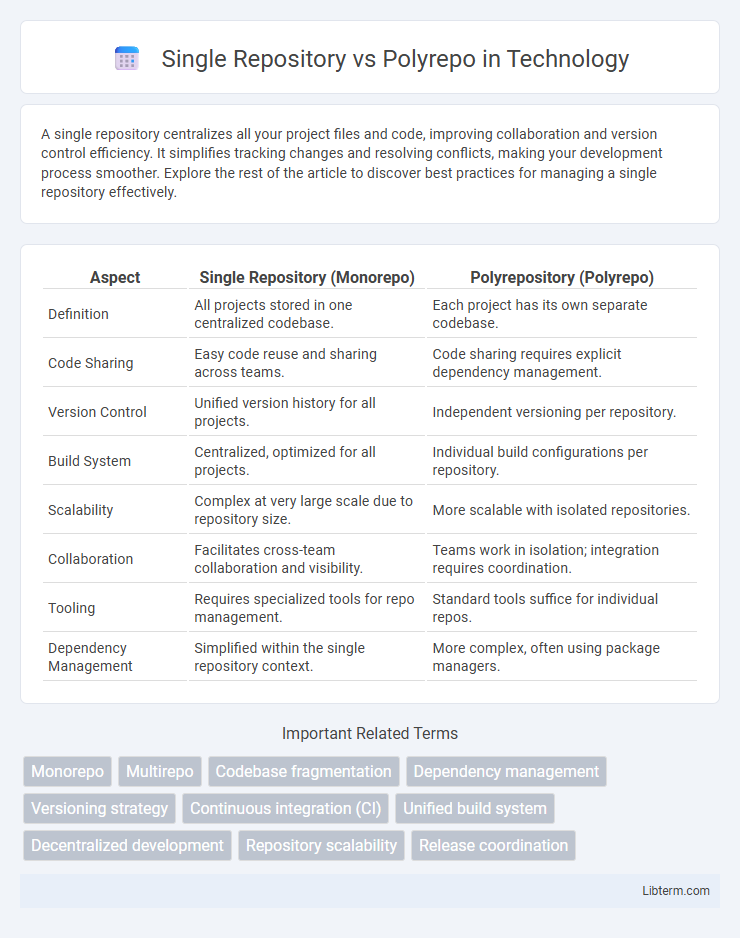A single repository centralizes all your project files and code, improving collaboration and version control efficiency. It simplifies tracking changes and resolving conflicts, making your development process smoother. Explore the rest of the article to discover best practices for managing a single repository effectively.
Table of Comparison
| Aspect | Single Repository (Monorepo) | Polyrepository (Polyrepo) |
|---|---|---|
| Definition | All projects stored in one centralized codebase. | Each project has its own separate codebase. |
| Code Sharing | Easy code reuse and sharing across teams. | Code sharing requires explicit dependency management. |
| Version Control | Unified version history for all projects. | Independent versioning per repository. |
| Build System | Centralized, optimized for all projects. | Individual build configurations per repository. |
| Scalability | Complex at very large scale due to repository size. | More scalable with isolated repositories. |
| Collaboration | Facilitates cross-team collaboration and visibility. | Teams work in isolation; integration requires coordination. |
| Tooling | Requires specialized tools for repo management. | Standard tools suffice for individual repos. |
| Dependency Management | Simplified within the single repository context. | More complex, often using package managers. |
Understanding Single Repository Architecture
Single repository architecture consolidates all codebases, configuration files, and dependencies into one central repository, streamlining version control and fostering uniform code standards across teams. This approach enhances collaboration by providing a unified view of the entire project, simplifies dependency management, and accelerates code integration through synchronized commits. Organizations adopting a single repository benefit from improved traceability, easier refactoring, and centralized build automation tools that support large-scale, multi-team development environments.
What is Polyrepo Architecture?
Polyrepo architecture involves managing multiple repositories, each containing a distinct project or service, enabling teams to work independently and deploy updates without affecting unrelated components. This approach enhances modularity, scalability, and security by isolating codebases, facilitating better version control and continuous integration specific to each repository. Unlike monolithic single repositories, polyrepo allows organizations to tailor development workflows and maintain cleaner dependency management across diverse projects.
Key Benefits of a Single Repository
A single repository offers centralized code management, simplifying version control and streamlining collaboration across development teams. It enhances code consistency by enabling comprehensive refactoring and easier dependency tracking within a unified environment. Centralized build and deployment processes in a single repository reduce integration overhead and accelerate release cycles.
Advantages of Polyrepo Approach
The polyrepo approach enables independent development cycles, allowing teams to deploy and scale microservices individually without impacting unrelated projects. It enhances security by limiting access to specific repositories, reducing the risk of widespread code exposure. Version control becomes more granular, facilitating easier rollback and tracking of changes within isolated codebases.
Challenges of Managing a Monorepo
Managing a monorepo presents challenges such as increased build times due to the large codebase and complex dependency graphs, making continuous integration pipelines harder to optimize. Version control operations become slower and more resource-intensive, potentially impacting developer productivity as conflicts and merges multiply. Ensuring consistent code quality across diverse projects requires robust tooling and strict governance to prevent technical debt and maintain scalability.
Drawbacks of Polyrepo Structure
Polyrepo structures often lead to complex dependency management and increased overhead in coordinating changes across multiple repositories, which can slow down development cycles. The lack of centralized visibility hinders large-scale refactoring and integration testing, causing potential inconsistencies and duplication of effort. Fragmented version control complicates traceability and cross-team collaboration, reducing overall productivity and increasing the risk of integration bugs.
Use Cases: When to Choose Single Repository
Single repository (monorepo) is ideal for large organizations managing multiple interdependent projects, facilitating consistent code sharing and streamlined dependency management. It enhances collaboration in teams working on tightly coupled components, enabling synchronized updates and simplified version control. Use a monorepo when atomic commits and unified CI/CD pipelines improve workflow efficiency across complex, interconnected codebases.
Use Cases: When to Choose Polyrepo
Polyrepo architecture suits organizations managing multiple independent projects requiring isolated version control, such as large enterprises with diverse development teams or companies maintaining distinct product lines. It enables granular access control and tailored workflows per repository, enhancing security and specialization without the complexity of a monolithic codebase. Development environments with varying technology stacks or frequent independent releases also benefit from polyrepo setups by reducing merge conflicts and streamlining continuous integration pipelines.
Migration Strategies Between Single and Polyrepo
Migration strategies between single repository (monorepo) and polyrepo structures require careful planning to maintain code integrity and streamline workflows. Transitioning from a monorepo to polyrepos typically involves modularizing the codebase, establishing clear dependency management, and implementing automated synchronization tools to keep repositories aligned. Moving from polyrepos to a monorepo demands consolidating disparate codebases, resolving conflicts in build processes, and adopting centralized version control systems for cohesive development and deployment.
Best Practices for Repository Management
Single repository (monorepo) management centralizes all codebases, enabling consistent dependency management and streamlined version control, which reduces integration challenges and promotes code reuse. Polyrepo structures isolate projects, facilitating independent deployment cycles and security boundaries, but require robust automation tools to maintain synchronization across repositories. Adopting clear branching strategies, automated CI/CD pipelines, and comprehensive documentation is essential in both approaches to ensure efficient collaboration and maintainability.
Single Repository Infographic

 libterm.com
libterm.com